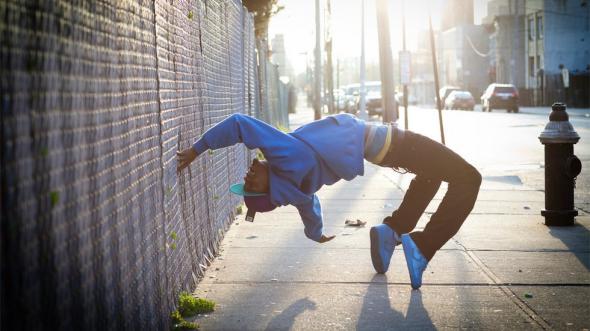Flex Is Kings Is the Perfect Antidote to the Step Up Series

Photo © Courtesy of Tribeca Film Festival/IMDb.com
In a few months, the fifth—yes, fifth—film in the very loosely connected Step Up franchise will be released. From all appearances, it’s just the same dance battle in a different venue: Even if you excuse the paint-by-numbers “plot” (a ragtag crew of “street” dancers assemble for yet another epic dance-off), choreographic innovation in this cinematic subgenre seems to have all but evaporated in the 30-plus years since Breakin’. Sure, you can dress the dances up with bigger stunts and flashier set pieces, but that won’t hide the fact that with each new dance movie, the recycled moves only become more unimaginative and repetitive underneath it all.
Which can be incredibly disappointing for dance enthusiasts—because, presumably, the dance numbers are the only reason to watch them in the first place. For those who are sick of the tired genre, Flex Is Kings, a documentary profiling Brooklyn street dancers, works as a nice antidote, with both entertaining performances and a focus on dancers trying to innovate and hone their craft. (Full disclosure: A friend of mine works for the film’s distributor.)
The documentary focuses on dancers who practice “flexing,” a style of storytelling through movement that finds the dancers’ bodies frequently contorted and distorted. It also includes popping and locking of the b-boy variety, but in flexing the movements are freakier and more extreme: Like contortionists, dancers bend limbs in directions that the average person can’t, popping them out of their sockets, and leaving them to dangle, slack. And even though flexing in America is frequently associated with hip hop, its origins actually lie in Jamaica, where it was developed in the ’90s by a dancer nicknamed Bruk Up (slang for “broken”) who suffered from a bone infection as a child.
The film, directed by Michael Beach Nichols and Deidre Schoo, stars several figures central to the flexing community in the neighborhood of East New York: dancers and friends Flizzo and Jay Donn, and Reem, a co-founder of Battlefest, a league of “extreme street dancers.” As in most Hollywood dance movies, the narrative is structured around a crucial dance competition, the Battlefest King of the Streets tournament; we follow along in the months leading up to the event as Reem organizes the battle and Flizzo and other dancers prepare. Simultaneously, Jay Donn is offered a unique opportunity to lend his “bone-breaking” talents to the role of Pinocchio (a clever bit of casting) with a New York-based theatrical dance company; the show is eventually performed at a festival in Edinburgh, Scotland.
As with other competition documentaries, there are the typical moments of direct address where the dancers eagerly confess their love of dancing or relate their hardships growing up, but Nichols and Schoo favor showing over telling. For most of the film, this works well, as the camera takes us into the fascinating creative process behind these dances, catching snippets of conversation during rehearsals or lingering on the dancers’ bodies as they work.
Yet what works for presenting the art itself sometimes gets in the way of the film’s own storytelling—scenes and storylines abruptly begin without any context, as with one unnecessarily jarring scene in which Flizzo and his girlfriend, who is featured primarily in the beginning, are suddenly in the midst of a dispute in the streets of their neighborhood, the nature of which never becomes clear. It ends as suddenly as it began, and is only briefly revisited before the film ends.
I also wished I could have seen the full performances in their original context. As the directors informed me, they didn’t use the same music used by the dancers (Jay Z, Rick Ross, etc.), because they couldn’t afford the necessary permissions—which is an understandable difficulty for a grassroots film project. But because the flexing style is so lyrical and rhythmic, the full effect of the dance is missing when the new instrumental scoring doesn’t align so perfectly. (In scenes where they are rehearsing, at least, the actual music is often heard playing in the background.) Luckily for those who want to follow the movie by watching some dances in their proper context, there are plenty of YouTube videos that will give viewers unfamiliar with flexing a chance to experience it as best as they can without actually being present for a live performance.
Even given these drawbacks, Flex Is Kings is worth seeing for dance enthusiasts and documentary fans alike; it opens for a limited run in New York City today and will be screening elsewhere across the country in the coming weeks. For those interested in dance and the artistic process, as well as what drives these characters to pursue a skill that provides no guarantee of a decent paycheck, Flex Is Kings is the dance movie for you. For the rest, there’s always another Step Up.

